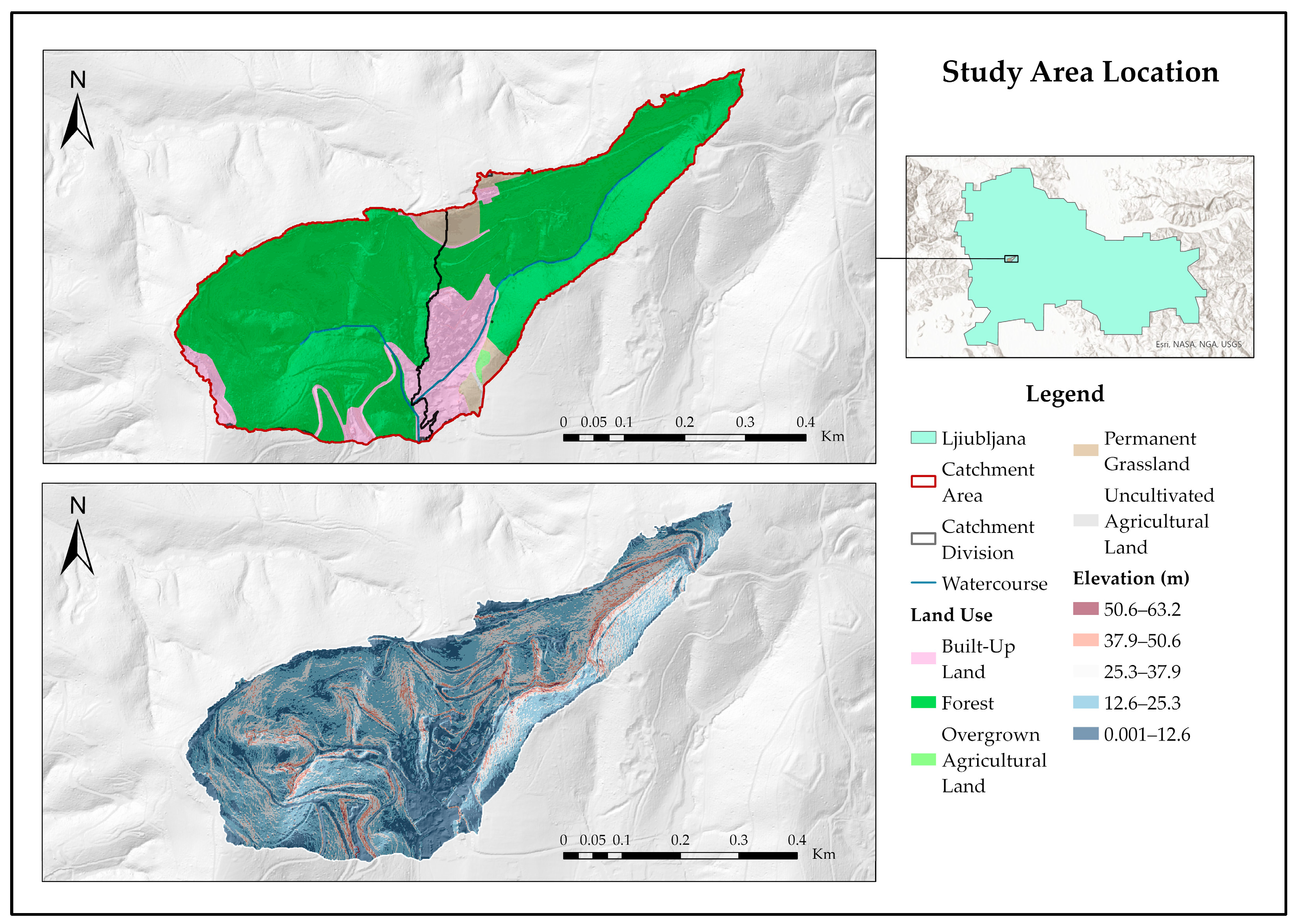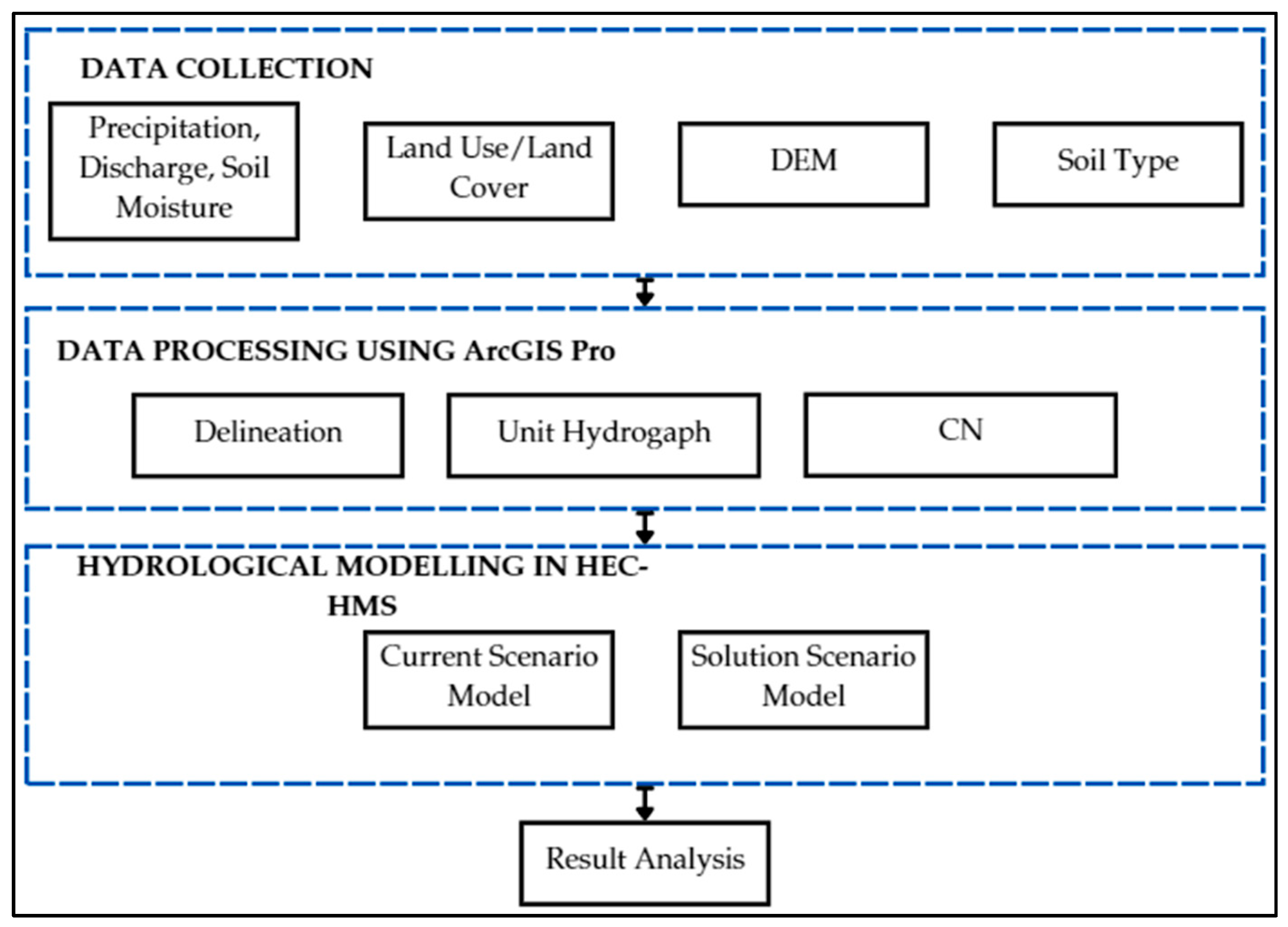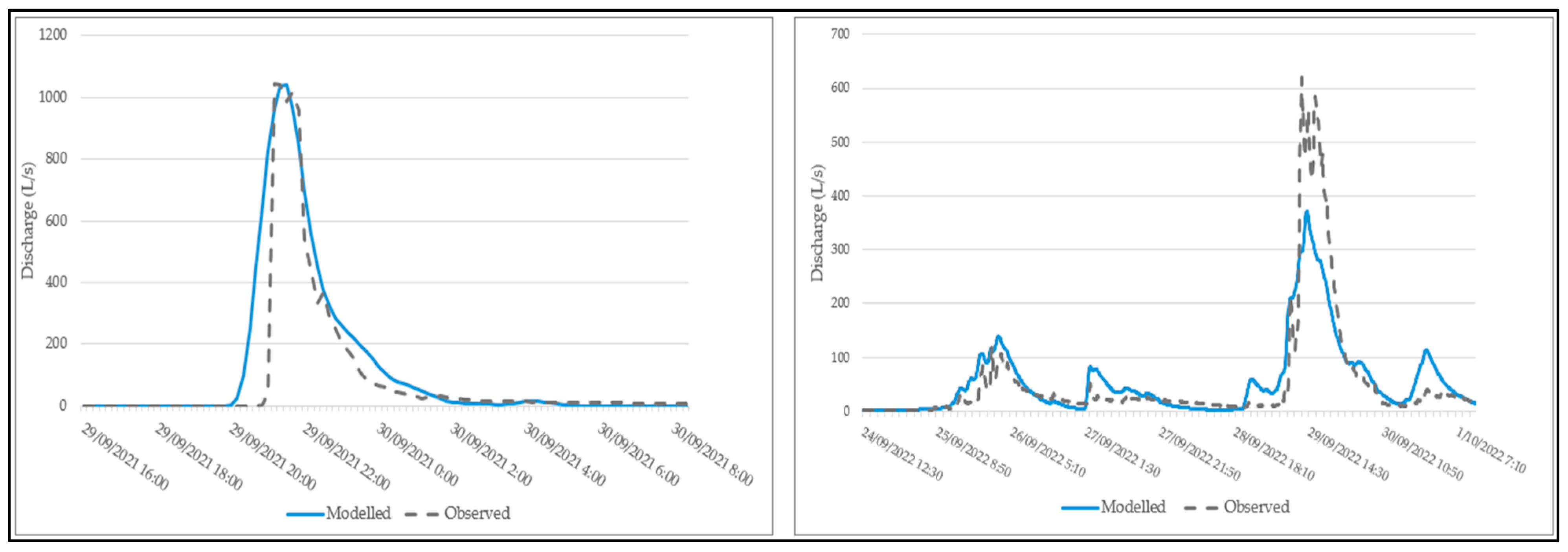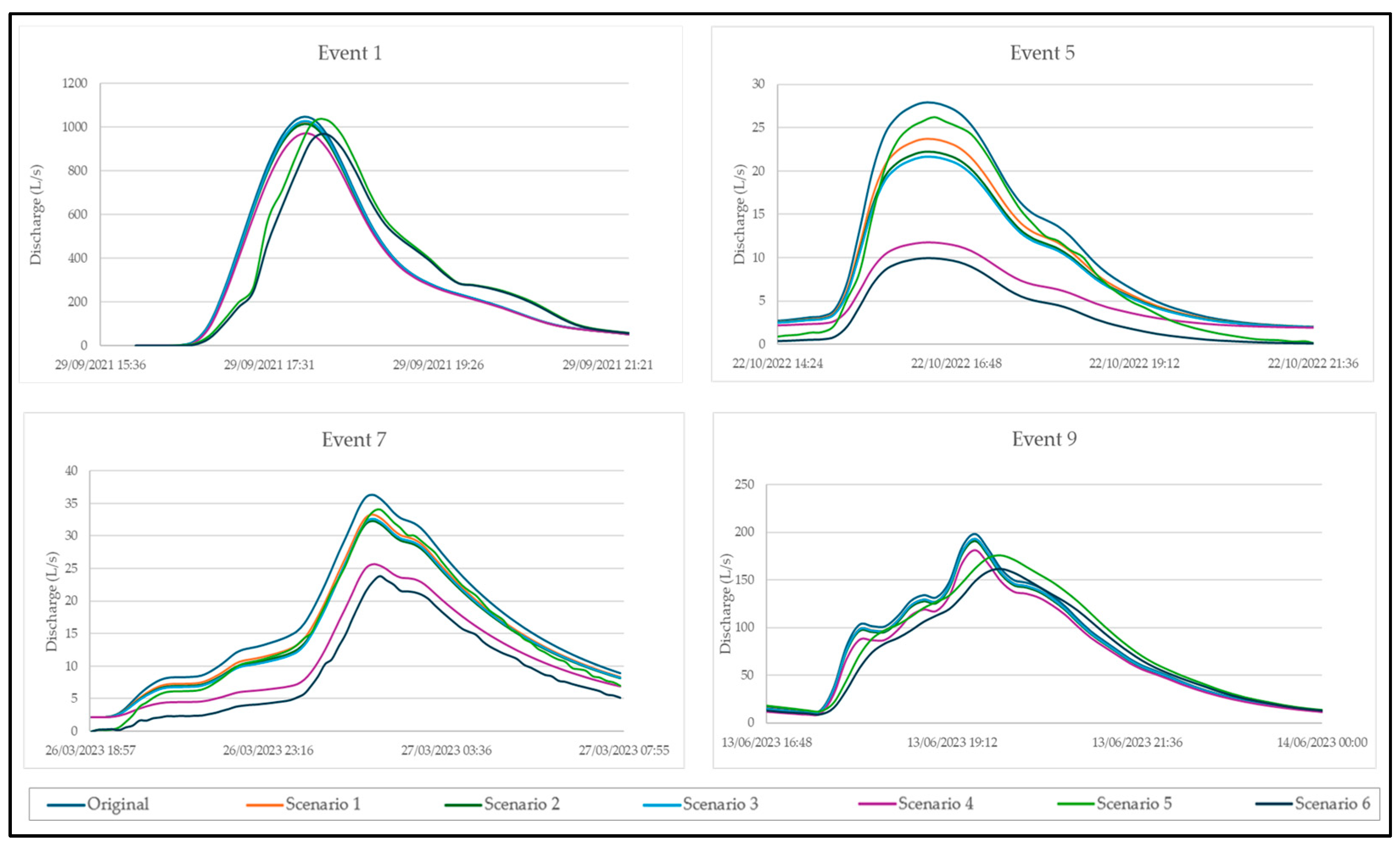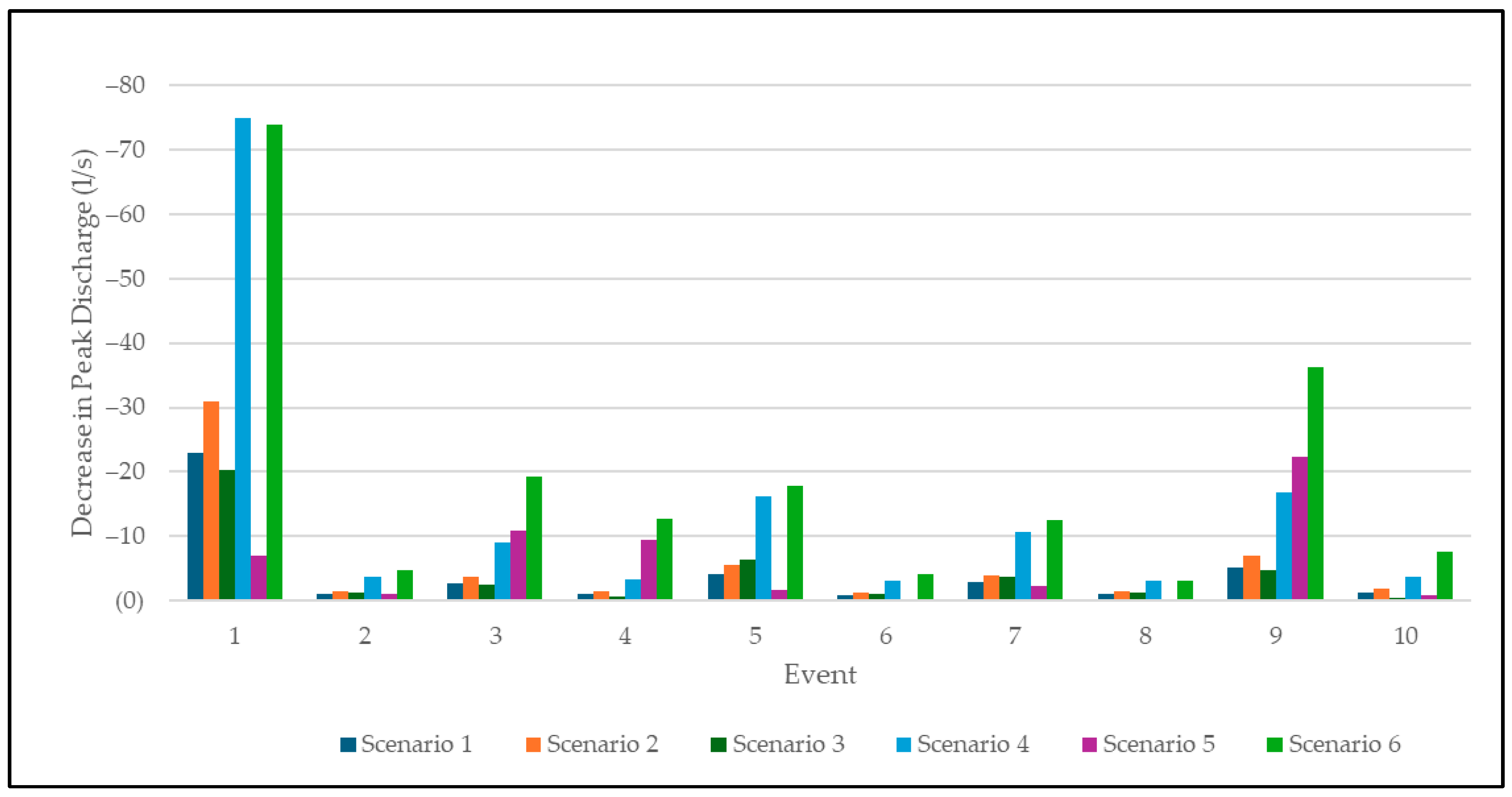1. Introduction
Runoff management has become a key topic in water management in recent times, particularly in the context of urban water drainage, flood management and climate change adaptation [
1,
2,
3,
4,
5]. Runoff processes determine how much precipitation becomes surface runoff. It is a key hydrological process, and its relevance is emphasised due to the extent to which human activities can alter this process. In both rural and urban areas, land use drastically changes runoff processes [
6,
7,
8]. Different areas and ecosystems experience different issues regarding runoff processes, which can be globally driven.
Climate change and rapid urbanisation are expected to exacerbate the potential negative impacts of runoff [
4,
5,
9]. Extreme storm events are projected to become more frequent and severe [
10,
11]. The continuous expansion of urban areas leads to greater areas of impermeability [
3,
5]. Flooding due to sealed surfaces related to urbanisation is present in many built-up areas worldwide [
3,
12,
13]. Often, the flood risk in these areas comes from extreme storm events, where high-intensity precipitation events result in water not being able to infiltrate or drain away. This causes high peak discharges in urbanised sub-catchments. Understanding the behaviour of runoff can help reduce flood risk in these areas and plan possible mitigation measures.
In many cases of runoff management, nature-based solutions (NbS) are frequently being proposed [
2,
14,
15,
16,
17]. NbS are often preferred to grey infrastructure in environmentally sensitive areas. They help provide cooling, fresh air and a better ambience for locals compared to grey infrastructure [
18]. Additionally, NbS typically provide much better infiltration, which can help build drought resilience and maintain ecosystems [
19]. Many issues arising from changes in runoff processes come from human activity. NbS aim to mimic natural processes and are being introduced in many cities around the world [
20]. They help decrease surface runoff by increasing infiltration, which can benefit groundwater recharge and help maintain environmental flows in dry periods [
2,
20]. Common examples of NbS include bioswales, permeable paving, green roofs and infiltration trenches [
21,
22,
23,
24].
NbS hold great promise, but it is important to quantify the changes in runoff that their implementation would provide. This type of analysis is significant both for the engineers tasked with designing such solutions and for the stakeholders who are involved in such projects. Hydrological modelling is a key tool for quantifying runoff changes under different scenarios. As sustainable runoff management becomes increasingly crucial, runoff modelling is being utilised to gain a deeper understanding of the factors influencing runoff and to predict how changes in a watershed affect these processes, as well as predicting the impact of runoff reduction mitigation measures.
The modelling of NbS is an emerging topic, and therefore, the performance of NbS in different contexts is not fully understood [
25,
26,
27]. The evaluation of NbS performance under extreme events in particular can be developed further [
28,
29]. Different storms can have unique hydrological responses based on their intensity and duration [
30,
31,
32]. The infiltration methods used in modelling often fail to account for this, leading to inaccuracies [
33]. When using the SCS-CN method [
34], tailoring the CN values to reflect these characteristics may allow for a better representation of the runoff response and improve model accuracy [
35]. New models have been developed for specific cases, and NbS projects have been modelled using pre-existing models. For example, MIKE-SHE can be used for modelling some NbS, such as implementing trees and green roofs [
2]. SWMM is commonly used due to its specific modules for NbS modelling, referred to as low-impact developments (LIDs) [
14,
36,
37]. Various NbS have been modelled using HEC-HMS, including rainwater harvesting [
38], retention ponds [
39], bioswales [
40] and changes in land use [
39,
40].
The aim of this research was to assess the effectiveness of different NbS in runoff and peak discharge management in the study area using hydrological modelling. This was achieved by developing and calibrating a HEC-HMS model of the current situation (baseline scenario) and implementing selected NbS into the basin and analysing the effect on runoff and peak discharge. Based on the results, the best NbS measures to mitigate peak discharge concerns and improve ecological conditions are recommended.
3. Results
Model Calibration
Calibration of the model was performed independently for each of the 10 rainfall events to best represent the peak discharge and runoff volume. The events included a variety of durations and intensities (
Table 3). An NSE value greater than 0.50 indicates that the model has acceptable predictive capability [
47], showing that the model effectively replicates the observed runoff and flow patterns for all evaluated events. PBIAS measures the average tendency of the model to overestimate or underestimate the observed values. PBIAS values within the range of ±25% to ±50% are considered acceptable, according to the criteria of Moriasi et al. [
47]. Negative values indicate that the model tends to systematically overestimate flow or runoff. In all events, the calibrations resulted in an adequately accurate model that also retained realistic parameters for the basin.
The statistics, including the root mean square error (RMSE), Nash–Sutcliffe efficiency (NSE) and percent bias (PBIAS), for each event are summarised in
Table 4, and examples of observed and modelled hydrographs from the calibration are shown in
Figure 4.
The implementation of different scenarios enables the performance of different NbS to be evaluated in terms of efficiency, providing a more complete view on which solutions are most effective in controlling the flow and mitigating the flood risk in each specific context.
The graphs for the four events show the discharges for each of the scenarios compared to the value for the scenario without any implementation (
Figure 5). For smaller events, such as Event 5 and Event 7, a significant difference in discharges is observed, which can be attributed to the ability of NbS to manage smaller flows more effectively. All events showed a reduction in flow for most scenarios. In particular, Scenario 6, which included the implementation of all NbS, showed the largest decrease in discharge, evidencing its effectiveness in controlling flow.
The biggest decrease in peak discharge between scenarios was observed in Scenario 4 in all events, except Event 1 (
Table 5;
Figure 6). The scenarios for individual solutions had minimal impact on peak discharge, although Scenario 2 (permeable parking) performed slightly better than the permeable streets and green roof. The degree to which the peak discharge was reduced varied greatly between the modelled events and did not appear to be influenced by the magnitude of the original peak discharge of the event. However, the best performance was observed in Event 1, which had the highest original peak discharge.
Table 6 shows the percentage decrease in surface runoff compared to the “No solutions” scenario for each event. Scenarios 5 and 6 are not included, as surface runoff volume is not affected by the ponds. The ponds’ effects are instead a result of water storage, affecting the peak discharge and lag time. Hence, storing water in ponds can significantly slow the runoff process, and the water can potentially be used for other purposes as well. In all events, the percent decrease showed that the applied strategies are effective in reducing runoff, either by increasing water retention or infiltration. This effect is particularly noticeable in Events 2, 5 and 6, where the percent change values are high, suggesting a considerable improvement in water management compared to the “No solutions” scenario.
Scenario 4 consistently stands out due to its high impact on percent change, showing better values in most events compared to other scenarios. This suggests that the combination of all NbS in this scenario is effective in reducing runoff volume and increasing water retention. Events 10 and 4 exhibit a smaller decrease in percentage change. However, this behaviour may be linked to the intensity and magnitude of the event. In Scenario 1, there were relatively small reductions in runoff, with the largest reduction occurring in Event 5. Scenarios 2 and 3 present similar results, although Scenario 3 is less effective in certain events.
The scenarios evaluated in
Table 7 indicate how implementation of the scenarios can influence the timing of peak discharge. For example, delaying the peak (as in the events in Scenario 3) can help distribute the volume of water in a more manageable way. In contrast, Scenario 4 shows no changes in delay time compared to Scenario 1, in which no interventions were applied. Events 2 and 5 also showed no changes in delay time, while the other events showed variations in a range of between 10 and 40 min.
4. Discussion and Possible Study Limitations
The results of the model allowed for a comparison of the NbS using the changes observed in runoff and peak discharge. All NbS combinations were associated with a decrease in runoff volume, along with a decrease in peak discharge. Multiple scenarios also showed a delay in the peak discharge. These results from the model suggest that the proposed NbS could be an effective way of mitigating the issues with runoff management in the study area.
When comparing the three solutions implemented in the east sub-catchment separately, Scenario 2 (permeable parking) presents the best results in terms of percent change in runoff volume. It presents the highest runoff reduction in Scenarios 1–3 in 9 out of the 10 simulations. This trend is also reflected in the effect on peak discharge. In all events, the use of permeable parking is more effective in reducing peak discharge compared to the other two solutions. In this case study, the parking area represents the largest single impervious area. Restoring permeability thus leads to the largest reduction in runoff and peak discharge of the modelled solutions. This finding is important because it indicates that this specific solution could be effective in similar contexts, where a small catchment has a significant area of permeability and shares specific characteristics of the terrain and the storm event. In this case, permeable parking is shown as most effective in flood mitigation.
The ponds reduced the peak discharge significantly in most cases and therefore helped overall performance when combined with the other NbS. Scenario 6 was the best performing scenario overall. The behaviour of the ponds and their impact on peak discharge changed between events and showed little correlation with the characteristics of each precipitation event. The ponds demonstrated a slight increase in lag time in most events due to water being stored in the ponds. The delay in discharge peak was between 0 and 40 min across the rainfall events compared to the “No solutions” scenario. In addition to delaying the peak, the ponds delayed the rising limb of the hydrographs and reduced the reactivity of the basin to precipitation. The hydrograph from Event 9 (
Figure 5) showed a smoother discharge curve as a result of water storage from pond implementation. The results of this study align with a previous work showing that ponds help reduce the peak discharge, smoothing and distributing floods over time and providing more time for infiltration [
73].
Scenarios 4 and 6 with all NbS implemented had the highest runoff % reduction for all simulations, and Scenario 6 performed best in reducing peak discharge. These findings emphasise the importance of implementing multiple solutions. This supports other literature works on nature-based solution analysis [
2,
70,
74] and the “sponge-city” concept [
20,
75].
Notable changes in runoff were observed when changing the impervious % parameter across the scenarios, especially in Scenario 3, where green roofs were modelled only by altering this parameter and not the CN. This highlighted the importance of this parameter in HEC-HMS models, as well as the overall significance of impervious surfaces in runoff processes. The results reaffirm the choice of NbS over grey infrastructure due to the reduction in impervious area, one of the main benefits associated with NbS.
As well as the changes in runoff and peak discharge, the NbS used in this study have differing levels of ecological benefits. Permeable paving does not contribute much to habitat provision compared to green roofs and ponds [
76]; therefore, although it is most effective in reducing runoff, it is not recommended as an independent solution due to the study area being part of a natural heritage site.
In very high rainfall events like Events 3, 4 and 10, the capacity of the implemented solutions to mitigate runoff volume may be overwhelmed, resulting in a lower reduction in runoff volume. Although the infiltration volume is increased, it can only be increased by a certain level, and once the saturation point is reached, the runoff rates will be high. This issue is also reflected in the changes in peak discharge. While the peak discharge volume is consistently reduced, this reduction in high discharge events is comparably small. Although the strategies may be effective in moderate rainfall, their effectiveness decreases when faced with extreme and prolonged rainfall events.
Events 1 and 3 resulted in differing performance of the NbS, likely due to large differences in precipitation intensity. Both are extreme rainfall events, with Event 1 having a return period (RP) of >100 years and Event 3 having a RP of >250 years. However, Event 1 has a very short duration (<8 h), whereas Event 3 is much longer (>50 h). While Event 3 has more rainfall in total, its lower average intensity (5.04 mm/h) allows the implemented solutions to work more efficiently by having more time to infiltrate and manage the water. In contrast, in Event 1, the higher average rainfall intensity (11.42 mm/h) causes a rapid accumulation of runoff, overcoming the capacity of the solutions to reduce the runoff volume, resulting in a smaller abatement. This highlights the difference in NbS response depending on the nature of the event. The CN method factors in precipitation intensity when calculating runoff volume [
34], which may explain this relationship.
The modelled reductions in runoff volume appear to change with the starting CN. This is apparent when the results from Events 3 and 10 are considered. They have comparable original runoff volumes (
Table 5), but the NbS perform very differently. Event 10 sees a runoff volume reduction of 1.4% with all NbS, whereas Event 3 has a reduction of 18.3% for the same scenario. Event 3 has an average precipitation intensity of 5.04 mm/hr, and Event 10 has an average precipitation intensity of 1.95 mm. This contradicts the idea that higher intensities reduce the effectiveness of the NbS. A possible cause is the starting CN of the two models. Event 3 has the lowest starting CN of all models, with 36. Event 10 has the highest starting CN, with 88 (
Table 2). Both deviate significantly from the average calibrated CN of 66.43 across all events. Therefore, the CN changes due to NbS implementation represent a greater proportion in terms of reduction in Event 3 than in Event 10 (a reduction in CN of 2.44% and 1.00%, respectively).
This research supports existing literature on the potential of NbS for runoff management. The green roofs in this study had a moderate impact, which varied with rainfall volume. This result correlates strongly with a study performed in Denmark, which showed very similar decreases in runoff volume [
77]. Permeable paving had the best performance in this study and was shown to be effective in other locations. In a case in Australia, permeable paving reduced the peak flows by 7–16%, which is comparable to the results in this case study [
78]. The limited effectiveness of retention ponds correlates with a similar modelled implementation in southeastern US [
79]. However, retention pond effectiveness varies greatly depending on the dimensions used and the dynamics of the watershed they are implemented in. Large-scale NbS, such as land use changes, tend to perform well [
39,
40]; however, they are not applicable to small watersheds, such as in this case study. For small urban catchments, a combination of small-scale measures is often the most effective solution [
2,
80], a statement, which this study also supports.
The outflow structures allowed for relatively high discharges in order for the model to function. This resulted in ponds not appearing as effective at reducing peak discharges and not providing water storage for longer durations, as water flowed out of the ponds immediately. Gates on the outflow structures are suggested, so that the discharge can be more closely regulated, which could be especially beneficial for maintaining water storage both on the surface and by recharging groundwater, so that the ponds can also serve an ecological purpose [
81]. Gates are a function in HEC-HMS but were not integrated into the model in this study.
The field measurements showed that runoff volumes from different rainfall events were inconsistent, with the proportion of effective rainfall to total precipitation changing significantly. The potential causes of this are changes in water storage in the catchment or changes in season. As the majority of the catchment is forest, the effects of leaves on the throughflow may alter runoff processes [
41,
45,
46]. The existing depressions in the topography may also contribute to this, and it is likely these storage functions also change seasonally. These inconsistencies meant harmonised parameters for the model that provided a good fit for all events were unable to be obtained.
The limitations of this study relate to the previously mentioned problems with calibration. Furthermore, HEC-HMS lacks specific functionality to implement NbS. In this case, the CN values and changes in impermeability were used as approximations. This implies that the exact locations of the solutions are not represented in the model, which could lead to variations in the results. Additionally, the absence of a change in the CN parameter for green roofs means that the model does not reflect the lagged runoff response compared to ordinary roofs. Although green roofs did not alter the CN, they achieved a reduction in runoff almost comparable to that of the permeable car park. This can be explained because the impervious data in this case are crucial, since the implementation of green roofs is the one that reduces the impervious area most compared to other solutions.
5. Conclusions
This study addressed the challenges related to high peak discharges and low-flow issues in the creek that enters the sewer system in the study area (i.e., Ljubljana, Slovenia). The analysis was conducted using HEC-HMS, evaluating different scenarios incorporating various nature-based solutions (NbS), as well as combinations of these solutions.
The implementation of permeable parking (Scenario 2) was the most efficient individual solution in reducing both runoff volume and peak flow in most simulations compared to green roofs, permeable streets and retention ponds. This is because permeable parking is key to reducing runoff by restoring permeability. Event 1 exhibited the greatest reduction in peak discharge, particularly in Scenarios 4 and 6, with a decrease of more than 70 l/s. Scenario 6, which combined all proposed nature-based solutions (NbS), was shown to be the most effective overall, with the largest reduction in peak flow. The implementation of multiple NbS is important for maximising benefits. Ponds were effective at increasing the lag times in most cases, helping to increase water storage and reduce peak discharges. The events that showed the best response to NbS implementation were small or shorter precipitation events. The impact was smaller for more extreme precipitation events with higher durations. Extreme rainfall volumes appeared to overwhelm the proposed solutions, as they became saturated part way through the event, at which point they lost their effectiveness.
Ponds can be effective in reducing peak flows under certain conditions, but their storage capacity is limited during extreme rainfall events, and they require improvements in flow control (e.g., outflow gates) to maximise their effectiveness, which were not considered in this study.
It was found that changing the impervious % for each scenario had an important impact on runoff and discharge. This highlights the benefit of NbS in terms of breaking up sealed urban areas and reflects a key benefit of NbS over grey infrastructure. The importance of this parameter in hydrological models is also reinforced.
HEC-HMS is a hydrological modelling software that, through adjustments to the CN and impervious areas, provides valuable insights into the impact of different infrastructures. Although HEC-HMS offers a useful approximation, exploring other hydrological models may improve the accuracy of the results and facilitate comprehensive performance evaluations of NbS.
